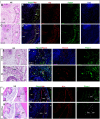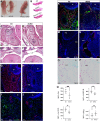Piezo1 and Piezo2 collectively regulate jawbone development
- PMID: 38619396
- PMCID: PMC11128276
- DOI: 10.1242/dev.202386
Piezo1 and Piezo2 collectively regulate jawbone development
Abstract
Piezo1 and Piezo2 are recently reported mechanosensory ion channels that transduce mechanical stimuli from the environment into intracellular biochemical signals in various tissues and organ systems. Here, we show that Piezo1 and Piezo2 display a robust expression during jawbone development. Deletion of Piezo1 in neural crest cells causes jawbone malformations in a small but significant number of mice. We further demonstrate that disruption of Piezo1 and Piezo2 in neural crest cells causes more striking defects in jawbone development than any single knockout, suggesting essential but partially redundant roles of Piezo1 and Piezo2. In addition, we observe defects in other neural crest derivatives such as malformation of the vascular smooth muscle in double knockout mice. Moreover, TUNEL examinations reveal excessive cell death in osteogenic cells of the maxillary and mandibular arches of the double knockout mice, suggesting that Piezo1 and Piezo2 together regulate cell survival during jawbone development. We further demonstrate that Yoda1, a Piezo1 agonist, promotes mineralization in the mandibular arches. Altogether, these data firmly establish that Piezo channels play important roles in regulating jawbone formation and maintenance.
Keywords: Jawbone; Mouse; Neural crest cell; Piezo1; Piezo2.
© 2024. Published by The Company of Biologists Ltd.
Conflict of interest statement
Competing interests The authors declare no competing or financial interests.
Figures




References
Publication types
MeSH terms
Substances
Grants and funding
LinkOut - more resources
Full Text Sources
Molecular Biology Databases

